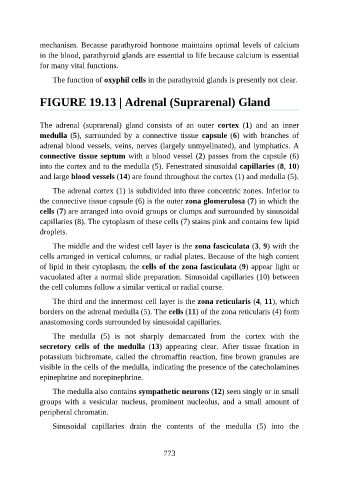Page 774 - Atlas of Histology with Functional Correlations
P. 774
mechanism. Because parathyroid hormone maintains optimal levels of calcium
in the blood, parathyroid glands are essential to life because calcium is essential
for many vital functions.
The function of oxyphil cells in the parathyroid glands is presently not clear.
FIGURE 19.13 | Adrenal (Suprarenal) Gland
The adrenal (suprarenal) gland consists of an outer cortex (1) and an inner
medulla (5), surrounded by a connective tissue capsule (6) with branches of
adrenal blood vessels, veins, nerves (largely unmyelinated), and lymphatics. A
connective tissue septum with a blood vessel (2) passes from the capsule (6)
into the cortex and to the medulla (5). Fenestrated sinusoidal capillaries (8, 10)
and large blood vessels (14) are found throughout the cortex (1) and medulla (5).
The adrenal cortex (1) is subdivided into three concentric zones. Inferior to
the connective tissue capsule (6) is the outer zona glomerulosa (7) in which the
cells (7) are arranged into ovoid groups or clumps and surrounded by sinusoidal
capillaries (8). The cytoplasm of these cells (7) stains pink and contains few lipid
droplets.
The middle and the widest cell layer is the zona fasciculata (3, 9) with the
cells arranged in vertical columns, or radial plates. Because of the high content
of lipid in their cytoplasm, the cells of the zona fasciculata (9) appear light or
vacuolated after a normal slide preparation. Sinusoidal capillaries (10) between
the cell columns follow a similar vertical or radial course.
The third and the innermost cell layer is the zona reticularis (4, 11), which
borders on the adrenal medulla (5). The cells (11) of the zona reticularis (4) form
anastomosing cords surrounded by sinusoidal capillaries.
The medulla (5) is not sharply demarcated from the cortex with the
secretory cells of the medulla (13) appearing clear. After tissue fixation in
potassium bichromate, called the chromaffin reaction, fine brown granules are
visible in the cells of the medulla, indicating the presence of the catecholamines
epinephrine and norepinephrine.
The medulla also contains sympathetic neurons (12) seen singly or in small
groups with a vesicular nucleus, prominent nucleolus, and a small amount of
peripheral chromatin.
Sinusoidal capillaries drain the contents of the medulla (5) into the
773

